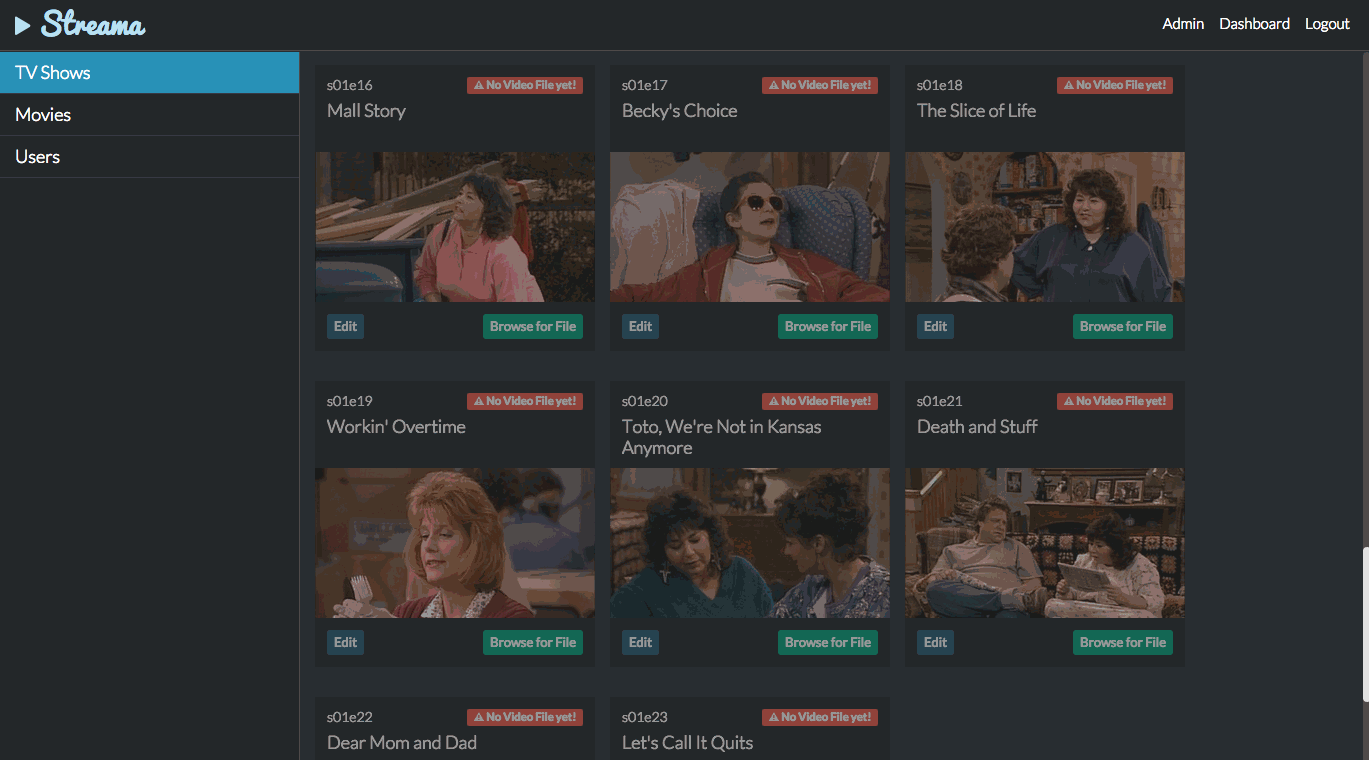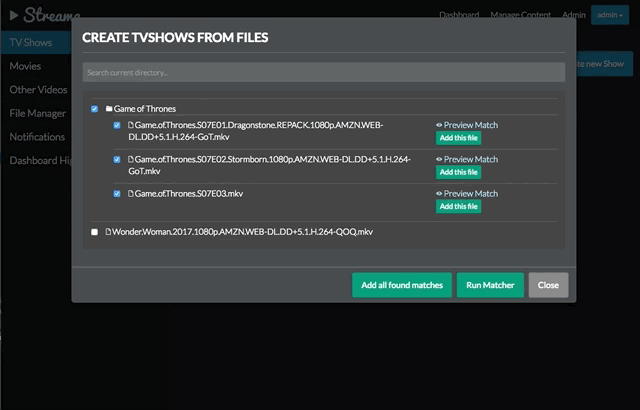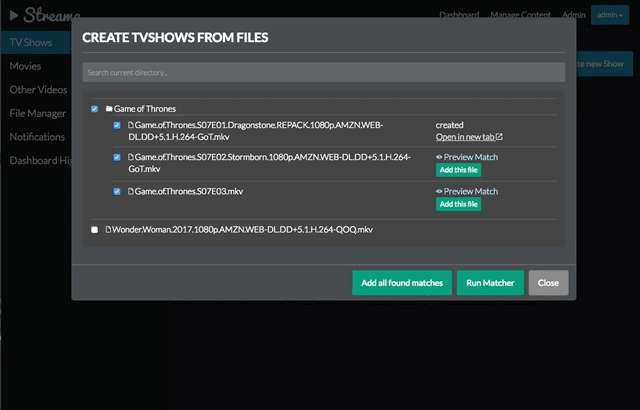Top Related Projects
The Free Software Media System - Server Backend & API
Emby Server is a personal media server with apps on just about every device.
Next generation Plex Desktop/Embedded Client
Kodi is an award-winning free and open source home theater/media center software and entertainment hub for digital media. With its beautiful interface and powerful skinning engine, it's available for Android, BSD, Linux, macOS, iOS, tvOS and Windows.
Collection of publicly available IPTV channels from all over the world
Quick Overview
Streama is an open-source, self-hosted media streaming server and web application. It allows users to host and stream their own media content, including movies, TV shows, and videos, with a user-friendly interface similar to popular streaming services like Netflix.
Pros
- Self-hosted solution, giving users full control over their media and data
- Customizable and extensible, with support for plugins and themes
- Cross-platform compatibility, accessible through web browsers on various devices
- Free and open-source, with an active community for support and development
Cons
- Requires technical knowledge for setup and maintenance
- Limited built-in content, as users need to provide their own media files
- May lack some advanced features found in commercial streaming services
- Potential legal concerns if used to stream copyrighted content without proper licenses
Getting Started
To set up Streama, follow these steps:
- Ensure you have Java 8 or later installed on your system.
- Download the latest Streama WAR file from the releases page.
- Run the application using the following command:
java -jar streama-X.Y.war
- Access the web interface at
http://localhost:8080. - Log in with the default credentials (admin/admin) and change the password.
- Configure your media directories and start adding content.
For a more detailed setup guide, including database configuration and deployment options, refer to the project's documentation on GitHub.
Competitor Comparisons
The Free Software Media System - Server Backend & API
Pros of Jellyfin
- More active development with frequent updates and releases
- Larger community and better documentation
- Supports a wider range of client devices and platforms
Cons of Jellyfin
- Higher system requirements for optimal performance
- Steeper learning curve for initial setup and configuration
Code Comparison
Jellyfin (C#):
public class MediaSourceInfo
{
public string Path { get; set; }
public string Protocol { get; set; }
public MediaProtocol? MediaProtocol { get; set; }
public TransportStreamTimestamp? TransportStreamTimestamp { get; set; }
public Dictionary<string, string> RequiredHttpHeaders { get; set; }
}
Streama (Groovy):
class Video {
String title
String description
Date dateCreated
Date lastUpdated
String posterImage
String imdb_id
String apiId
String overview
String originalLanguage
Date releaseDate
}
Both projects aim to provide media streaming solutions, but Jellyfin offers a more comprehensive and actively maintained platform. Jellyfin's codebase appears more structured and feature-rich, while Streama's code is simpler and more focused on basic video attributes. Jellyfin may be better suited for users seeking a full-featured media server, while Streama could be a good choice for those preferring a lightweight solution with a gentler learning curve.
Emby Server is a personal media server with apps on just about every device.
Pros of Emby
- More mature and feature-rich media server with broader device support
- Offers live TV and DVR functionality
- Has a larger and more active community, resulting in better support and more frequent updates
Cons of Emby
- Requires a paid subscription for premium features and some client apps
- More complex setup and configuration process
- Heavier resource usage, especially for transcoding
Code Comparison
Streama (Grails framework):
def index() {
def movies = Movie.list()
def shows = TvShow.list()
[movies: movies, shows: shows]
}
Emby (C#):
public async Task<QueryResult<BaseItem>> GetItemsAsync(InternalItemsQuery query)
{
var user = query.User;
var items = await GetItemsToProcess(query).ConfigureAwait(false);
return await ProcessQueryResult(items, query, user).ConfigureAwait(false);
}
While both projects are media servers, they use different technologies and approaches. Streama is built with Grails (Java-based) and focuses on simplicity, while Emby is developed in C# and offers more advanced features. Emby's codebase is generally more complex, reflecting its broader feature set and maturity.
Next generation Plex Desktop/Embedded Client
Pros of Plex Media Player
- More mature and feature-rich media player with a polished user interface
- Supports a wider range of media formats and codecs
- Better integration with other Plex ecosystem products
Cons of Plex Media Player
- Closed-source, limiting customization and community contributions
- Requires a Plex server setup, which can be more complex for beginners
- Some advanced features require a paid Plex Pass subscription
Code Comparison
Streama (JavaScript):
videojs(videoElement, {
playbackRates: [0.5, 1, 1.5, 2],
controlBar: {
children: [
'playToggle',
'volumePanel',
'currentTimeDisplay',
'progressControl',
'durationDisplay',
'playbackRateMenuButton',
'fullscreenToggle'
]
}
});
Plex Media Player (C++):
class MediaPlayer : public QObject
{
Q_OBJECT
public:
explicit MediaPlayer(QObject* parent = nullptr);
void play(const QUrl& url);
void pause();
void stop();
};
The code snippets show different approaches to media player implementation. Streama uses JavaScript with the Video.js library for a web-based player, while Plex Media Player uses C++ with Qt for a native desktop application. This reflects the different architectures and target platforms of the two projects.
Kodi is an award-winning free and open source home theater/media center software and entertainment hub for digital media. With its beautiful interface and powerful skinning engine, it's available for Android, BSD, Linux, macOS, iOS, tvOS and Windows.
Pros of XBMC
- More mature and feature-rich media center solution
- Supports a wide range of platforms (Windows, Linux, macOS, Android, etc.)
- Large community and extensive plugin ecosystem
Cons of XBMC
- Heavier resource usage, may not be suitable for low-powered devices
- Steeper learning curve for configuration and customization
- Primarily designed for local media playback, streaming features are secondary
Code Comparison
XBMC (C++):
bool CVideoPlayer::OpenDemuxStream()
{
if (m_pDemuxer)
{
m_pDemuxer->Open(m_item.GetDemuxResource());
return true;
}
return false;
}
Streama (Groovy):
def playVideo() {
def video = Video.get(params.id)
if (!video) {
render status: NOT_FOUND
return
}
respond video
}
While both projects deal with video playback, XBMC's codebase is more complex and focused on low-level media handling, whereas Streama's code is higher-level and web-oriented. XBMC is a comprehensive media center solution, while Streama is primarily a web-based streaming server. XBMC offers broader platform support and more features, but Streama may be easier to set up for simple streaming needs.
Collection of publicly available IPTV channels from all over the world
Pros of iptv
- Larger collection of free IPTV channels from around the world
- Regularly updated playlist with community contributions
- Simple to use with any IPTV player that supports M3U playlists
Cons of iptv
- No built-in player or user interface
- Limited features beyond providing channel lists
- Potential legal concerns with some streams
Code comparison
iptv (playlist entry):
#EXTINF:-1 tvg-id="BBCNews.uk" tvg-logo="https://i.imgur.com/vSz2WF6.png" group-title="News",BBC News HD
http://1111296894.rsc.cdn77.org/LS-ATL-54548-6/index.m3u8
streama (Grails controller snippet):
def save() {
def file = request.getFile('file')
def originalFilename = file.originalFilename
def fileName = UUID.randomUUID().toString() + '.' + originalFilename.substring(originalFilename.lastIndexOf('.') + 1)
file.transferTo(new File(uploadService.getPath() + fileName))
render status: OK
}
iptv focuses on providing a comprehensive list of IPTV channels in M3U format, while streama is a full-featured media server with a web-based interface for managing and streaming content. iptv is simpler to use but offers fewer features, whereas streama provides a more complete solution for hosting and managing media files.
Convert  designs to code with AI
designs to code with AI

Introducing Visual Copilot: A new AI model to turn Figma designs to high quality code using your components.
Try Visual CopilotREADME

STREAMA
Docs: https://docs.streama-project.com/
Ever had a huge bookshelf full of shows and movies? Ever wanted to digitalize them, but didn't have a good way of organizing the files? Worry no more! Streama is your own personal Netflix for just such a purpose!
Live-Demo
https://streama.demo-version.net/
credentials: username: demoUser | password: demoUser
Feel free to play around there as much as you like (everything is reset at night)
We will keep this demo updated with our newest releases as they come, so that you can check out new features there first before deciding to deploy them in your own environments.
Donate
If you want to donate to the developer via bitcoin use 17rCUEX6KYQ8ZM4w39ttEUL7SUDnGCpcWq
Table of contents:
- Getting Started
- Downloads
- The Application
- Technical Details
- Changelog
- Roadmap
- Known Issues
- Contributing
- License
Getting Started
If you have any issues getting started, feel free to chat with us on Discord. We are more than happy to assist and then improve the docs accordingly.
Downloads
- Stable and beta versions see the GitHub releases
The Application
Settings

When you first run the application, you will be redirected to the settings page. Here you enter your desired upload directory for the video files, your theMovieDb.org API key and a different base URL if so desired (useful for remote hosting).
Once you made adjustments to any of the settings, make sure to validate the value before saving.
- For the API-Key, the validation checks against theMovieDb.org to see if you've entered a valid API-key.
- For the upload directory, the application checks if it has read/write permissions for it.
The Dashboard

On the dashboard, a user can see their recently watched TV-shows and Movies and their progress (they can continue where they left off) as well start new shows and movies that they haven't yet seen. The "Continue Watching" Feature works by periodically updating the database (only while watching, of course!) with info about the currently watched Video and how far it has been seen.
If a Movie or Episode does not contain any video-files, it won't show up in the dashboard.
The Player

The Streama-Player is (heavily) inspired by Netflix, so you get all the good stuff from there. For Shows, there is a "next episode" button and a handy episode/season browser. There are also the basics: volume-control, play/pause, and fullscreen. Later down the road I will add a feature to add subtitles and switch between video-files (for instance for different quality uploads). The player is HTML5-based and has only really been tested in Chrome so far.
The Episode Browser
I am especially proud of the Episode-Browser, which aims to function just like on Netflix. By default, the current video files season is selected. The user gets an overview of which other episodes there are in the season, how many seasons there are, and, as an added feature, the user sees all the added episodes, even if no video-files are added to them (thus greyed out).

The Admin-Panel

One of the most important things to me was to make managing shows, movies, and episodes as easy and fun as possible. For this, I made heavy use of the API from theMovieDatabase.org, which auto-fills the episodes, shows and movies with useful information and great images. This eases the user's role in adding content.
For example, creating a new TV-show and the episodes for the first season looks something like this:

Uploading video-files for each episode is as easy as drag-and-drop!

Accessing existing files
If you want to avoid uploading every file, use our new and improved "Local File" Feature instead. You can define a local directory (I use one directly in which I created symlinks to all my mounted drives) and then you can either use the local file browser for individual movies / tv-Shows or you can use the bulk-create feature.
The local file browser
You can access the local file browser from any movie or TV-show (anywhere where you would otherwise upload a file). Note: You need to first define the local directory in the settings.


Bulk-Create from File
This MR addresses the issue "Batch Add Files #241". Note: the TV-Show does not have to be present in order for this to work. Everything will be created by the backend.
Running matcher & previewing the result

adding single matched file

adding files in bulk

Customizing the Matcher
Just like in Emby or Kodi, the matcher-regex can be altered. The two defaults are
Movie: /^(?<Name>.*)[_.]\(\d{4}\).*/
TvShow/Episode: /^(?<Name>.+)[._]S(?<Season>\d{2})E(?<Episode>\d{2,3}).*/
In order to customize the regex, just add the regex in the bottom of the application.yml like so:
streama:
regex:
movies: ^(?<Name>.*)[_.]\(\d{4}\).*
shows: ^(?<Name>.+)[._]S(?<Season>\d{2})E(?<Episode>\d{2,3}).*
The Users
 Users can be invited and managed in the admin panel. By default, they are non-admins, meaning they can only view videos, not create them. You can make them admins with the press of a button. Since there is user-administration in place, I plan on expanding on this a lot! Another feature I want to add is the ability for users to add and administer some form of playlists. There is a lot of potentials to make this even better!
Users can be invited and managed in the admin panel. By default, they are non-admins, meaning they can only view videos, not create them. You can make them admins with the press of a button. Since there is user-administration in place, I plan on expanding on this a lot! Another feature I want to add is the ability for users to add and administer some form of playlists. There is a lot of potentials to make this even better!
Technical Details
This application is web-based, the server-side is written on Grails 3 with SpringSecurity for login & user-handling. For all the front-end components, AngularJS is used and the player is completely HTML5-based. The application is essentially split into Grails for a REST-API, and AngularJS for the frontend.
Streama uses the awesome API from theMovieDatabase for all media-metadata.
Changelog
Please refer to the description of each release or the git log.
Roadmap
Streama is still very much a work-in-progress. We will be adding new features and bug-fixes often, but this is a hobby project for the core-contributors, so the time that we can spend on it is limited.
For all our feature and bug tracking, we use the Issues Section. Streama's 'roadmap' is currently to work through the feature requests and improvements that are in the issue tracker. Take a look at the milestones for what we intend to add for upcoming releases.
Contributing
Features, Improvements, and Bugfixes
Streama currently only has ~2-3 core-contributors so we are grateful for any extra contributions. Send through a Pull Request and we will review it ASAP.
If you're not sure what to work on, take a look at the issues. There are lots to do!
Translations
If you want to contribute a translation, please follow the guide here.
Known Issues
- There is no video-conversion currently, meaning you are reliant upon HTML5 browser compatibilities. Server-side conversion is on our roadmap. See Issue #440
License
Streama is distributed under the terms of the MIT license. See LICENSE.md for details.
Top Related Projects
The Free Software Media System - Server Backend & API
Emby Server is a personal media server with apps on just about every device.
Next generation Plex Desktop/Embedded Client
Kodi is an award-winning free and open source home theater/media center software and entertainment hub for digital media. With its beautiful interface and powerful skinning engine, it's available for Android, BSD, Linux, macOS, iOS, tvOS and Windows.
Collection of publicly available IPTV channels from all over the world
Convert  designs to code with AI
designs to code with AI

Introducing Visual Copilot: A new AI model to turn Figma designs to high quality code using your components.
Try Visual Copilot







